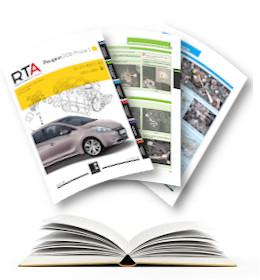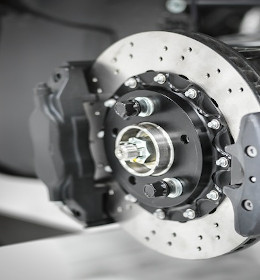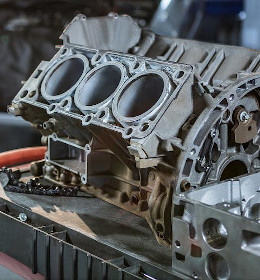Que signifie votre code Code Défaut AUDI ?
Grace au système OBD, les
Audi
fabriqués après 1996 sont normalement équipés d'une prise diagnostique OBD.
Si l'ordinateur de la voiture rencontre un problème,un code d'erreur ou un code de diagnostic (DTC)
sera stocké dans la mémoire de l'ECU de la voiture.
Avec un lecteur OBD branché sur le port OBD (On-Board Diagnostics) de la voiture, vous pouvez lire la liste des codes stockés, et donc découvrir quel est le problème.
Les codes suivent une formule permettant de savoir généralement quel est le problème avant même de regarder le tableau ci-dessous.
Nous vous présentons ci-dessus une liste très complète des différents codes défauts possibles.
Si le code défaut de votre auto s'affiche au tableau de bord, vous n'aurez peut-être même pas besoin d'un lecteur OBD . il sera dans la liste .
Réparer le code défaut de votre auto, c'est potentiellement simple à faire avec vos revues et méthodes techniques.

Réparer le code défaut de votre auto, c’est potentiellement simple à faire avec nos revues et méthodes techniques
| Code | Libellé |
|---|---|
| P2083 | Exhaust gas temperature sensor in front of catalytic converter 2, circuit intermittent |
| P2084 | Exhaust gas temperature sensor behind the catalytic converter, circuit range/performance (bank 1) |
| P2085 | Exhaust gas temperature sensor behind the catalytic converter, circuit intermittent (bank 1) |
| P2086 | Exhaust gas temperature sensor behind the catalytic converter, circuit range/performance (bank 2) |
| P2087 | Exhaust gas temperature sensor behind the catalytic converter, circuit intermittent (bank 2) |
| P2088 | Inlet camshaft timing solenoid 1 circuit low |
| P2089 | Inlet camshaft timing solenoid 1 circuit high |
| P208A | Reductant pump control circuit /open |
| P208B | Reductant pump control circuit range/performance |
| P208C | Reductant pump control circuit low |
| P208D | Reductant pump control circuit high |
| P208E | Reductant injector 1 stuck closed (bank 1) |
| P208F | Reductant injector 1 stuck closed (bank 2) |
| P2090 | Exhaust camshaft timing solenoid 1 circuit low |
| P2091 | Exhaust camshaft timing solenoid 1 circuit high |
| P2092 | Inlet camshaft timing solenoid 2 circuit low |
| P2093 | Inlet camshaft timing solenoid 2 circuit high |
| P2094 | Exhaust camshaft timing solenoid 2 circuit low |
| P2095 | Exhaust camshaft timing solenoid 2 circuit high |
| P2096 | Post-catalytic converter fuel trim system too lean (bank 1) |
| P2097 | Post-catalytic converter fuel trim system too rich (bank 1) |
| P2098 | Post-catalytic converter fuel trim system too lean (bank 2) |
| P2099 | Post-catalytic converter fuel trim system too rich (bank 2) |
| P209A | Reductant injection air pressure sensor circuit/open |
| P209B | Reductant injection air pressure sensor circuit range/performance |
| P209C | Reductant injection air pressure sensor circuit low |
| P209D | Reductant injection air pressure sensor circuit high |
| P209E | Reductant injection air pressure sensor 1 correlation with reductant injection air pressure sensor 2 |
| P209F | Reductant tank heater circuit range/performance |
| P20A0 | Reductant purge control solenoid circuit/open |
| P20A1 | Reductant purge control solenoid circuit range/performance |
| P20A2 | Reductant purge control solenoid circuit low |
| P20A3 | Reductant purge control solenoid circuit high |
| P20A4 | Reductant purge control solenoid stuck open |
| P20A5 | Reductant purge control solenoid stuck closed |
| P20A6 | Reductant injection air pressure control valve circuit/open |
| P20A7 | Reductant injection air pressure control valve range/performance |
| P20A8 | Reductant injection air pressure control valve circuit low |
| P20A9 | Reductant injection air pressure control valve circuit high |
| P20AA | Reductant injection air pressure control valve stuck open |
| P20AB | Reductant injection air pressure control valve stuck closed |
| P20B2 | Reductant heater coolant control valve range/performance |
| P20B5 | Reductant heater 1 circuit/open |
| P20B9 | Reductant heater 1 circuit/open |
| P20BA | Reductant heater 1 circuit range/performance |
| P20BB | Reductant heater 1 circuit low |
| P20BC | Reductant heater 1 circuit high |
| P20BD | Reductant heater 2 circuit/open |
| P20BE | Reductant heater 2 circuit range/performance |
| P20BF | Reductant heater 2 circuit low |
| P20C0 | Reductant heater 2 circuit high |
| P20C1 | Reductant heater 3 circuit/open |
| P20C2 | Reductant heater 3 circuit range/performance |
| P20C3 | Reductant heater 3 circuit low |
| P20C4 | Reductant heater 3 circuit high |
| P20C5 | Reductant heater 4 circuit/open |
| P20C6 | Reductant heater 4 circuit range/performance |
| P20C7 | Reductant heater 4 circuit low |
| P20C8 | Reductant heater 4 circuit high |
| P20C9 | Reductant control unit MIL request |
| P20CA | Reductant injection air pressure system leakage detected |
| P20CB | Exhaust-mounted injector 1 circuit/open |
| P20CC | Exhaust-mounted injector 1 range/performance |
| P20CD | Exhaust-mounted injector 1 circuit low |
| P20CE | Exhaust-mounted injector 1 circuit high |
| P20CF | Exhaust-mounted injector 1 stuck open |
| P20D0 | Exhaust-mounted injector 1 stuck closed |
| P20D1 | Exhaust-mounted injector 2 circuit/open |
| P20D2 | Exhaust-mounted injector 2 range/performance |
| P20D3 | Exhaust-mounted injector 2 circuit low |
| P20D4 | Exhaust-mounted injector 2 circuit high |
| P20D5 | Exhaust-mounted injector 2 stuck open |
| P20D6 | Exhaust-mounted injector 2 stuck closed |
| P20E2 | Exhaust gas temperature sensor 1 correlation with exhaust gas temperature sensor 2 (bank 1) |
| P20E3 | Exhaust gas temperature sensor 1 correlation with exhaust gas temperature sensor 3 (bank 1) |
| P20E4 | Exhaust gas temperature sensor 2 correlation with exhaust gas temperature sensor 3 (bank 1) |
| P20E5 | Exhaust gas temperature sensor 1 correlation with exhaust gas temperature sensor 2 (bank 2) |
| P20E6 | Reductant injection air pressure too low |
| P20E7 | Reductant injection air pressure too high |
| P20E8 | Reductant pressure too low |
| P20E9 | Reductant pressure too high |
| P20EC | NOx catalytic converter temperature too high (bank 1) |
| P20ED | NOx pre-catalytic converter temperature too high (bank 1) |
| P20EE | NOx catalytic converter system efficiency below threshold (bank 1) |
| P20EF | NOx pre-catalytic converter system efficiency below threshold (bank 1) |
| P20F0 | NOx catalytic converter temperature too high (bank 2) |
| P20F1 | NOx pre-catalytic converter temperature too high (bank 2) |
| P20F2 | NOx catalytic converter system efficiency below threshold (bank 2) |
| P20F3 | NOx pre-catalytic converter system efficiency below threshold (bank 2) |
| P20F4 | Reductant consumption too low |
| P20F5 | Reductant consumption too high |
| P20F6 | Reductant injector 1 stuck open (bank 1) |
| P20F7 | Reductant injector 1 stuck open (bank 2) |
| P20F8 | Inlet manifold runner control circuit range/performance (bank 1) |
| P20F9 | Inlet manifold runner control circuit range/performance (bank 2) |
| P20FA | Reductant pump 2 control circuit/open |
| P20FB | Reductant pump 2 control circuit range/performance |
| P20FC | Reductant pump 2 control circuit low |
| P20FD | Reductant pump 2 control circuit high |
| P20FF | Reductant control unit range/performance |
DEFINISSEZ VOTRE MARQUE POUR ACCEDER A VOS CODES DEFAUTS
-
Revue technique RTA

Revue Technique Automobile
La revue technique de référence depuis 1946. La RTA est une revue papier pour tous publics, qui vous permet d'effectuer les petites et les grosses réparations
 Voir le descriptif
Voir le descriptif
-
Entretien courant MTA

Méthode Technique Automobile
La MTA est issue de nos outils destinés aux pros de l'auto. Ces méthodes en ligne permettent d'effectuer les opérations de maintenances de votre auto (filtres, courroies, etc.)
 Voir le descriptif
Voir le descriptif
-
Toutes réparations MTAx

Méthode Technique Automobile Expert
La MTA expert est un outil en ligne destiné aux experts en mécanique et en carrosserie, pour effectuer tous types de réparations sur une voiture.
 Voir le descriptif
Voir le descriptif















